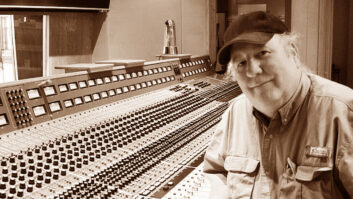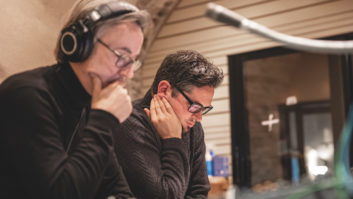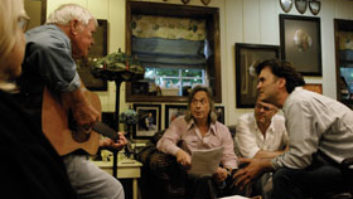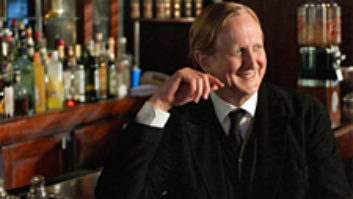Ralph Stanley is known for his quiet demeanor. Of course, when you’re a “man of constant sorrow,” perhaps it’s best to let the music do the talking, which is exactly what the legendary bluegrass and old-time singer does on his latest self-titled release. The project finds Stanley weaving his trademark voice around age-old traditionals and gospel songs in a stark, 11-track package produced by T Bone Burnett and recorded by his longtime engineer, Mike Piersante — the same team who worked on the multi-Platinum soundtrack album to O Brother, Where Art Thou?.
“That was the first time we ever worked together,” says Stanley of the O Brother album, which showcased his distinctive wail on “O Death” and also featured a version of “Angel Band” from his days performing with his brother Carter. “And after that did good, T Bone said he’d like me to do a CD with him with a lot of old-time songs on it. So I told him okay, and he sent me a letter with [a list of] old-time songs and I picked out a lot of them for us to record. I really didn’t know that much about [Burnett], but I knew he’d done a good job with O Brother, so I was willing to take his judgment on one for me.”
Stanley and Burnett went into the project with a specific goal in mind: to reintroduce traditional songs, some over 300 years old, to a new audience — particularly the audience that snapped up copies of the O Brother soundtrack and packed venues on last year’s Down From the Mountain tour, which Stanley closed every night.
“This particular album was all about live performance [in the studio],” says engineer Piersante, “not only sonically but from a musical standpoint. The gut feeling you get from the music, the players and playing live together.
“Mixing it was a lot of just balancing the instruments out and putting them at the right level. These musicians are used to performing on a single mic onstage, where the singer moves back and the guitarist moves up. We used this approach on the record. They were all together in the room: [Stanley] was right there and could reach out and touch the guitar and mandolin players.”
The approach was a change of pace even for Stanley. “We were close together where we could hear each other, no monitors, and that’s the way I did it when I first started recording,” Stanley says. “A lot of us ganged around one mic, but now the studio has little rooms and one musician is in one room and a couple in another, and you need earphones to hear everybody. That’s how I’ve recorded for the last several years. It was T Bone’s idea to go back to basics.”
Working on such a bare-bones project, says Piersante, “takes you to a new level because the less you record, the more important each individual thing becomes. Usually, if one thing is not stellar, you can bury or hide it under 20 other things. But when all you’ve got is six mics live, you’ve got to make sure that you’re getting back what you need; otherwise, you’re dead in the water.”
The album was recorded at Sound Emporium in Nashville, which Piersante describes as “a great-sounding live room for acoustic instruments, one of the great rooms in the country.” The project took a mere three weeks to cut, although, Stanley notes, “I have done an album in one day. T Bone takes his time. Where I’ll go in, sing one song and I’m ready to do another, he takes a break and talks over the songs and arrangements.”
“We took a couple of trips back to Nashville, a week at a time,” says Piersante. “Maybe tried songs a few different ways with instrumentation and keys, got a master tape of that, and then it took five or six days to mix.” In the end, they were looking for the best and most emotional performances rather than attempt to patch together songs from multiple takes.
“Producers nowadays want a lot of overdubs so that they can take a word or half of a word out,” Stanley says. “The reason for that is, they might find a verse in the first cut and another verse in the fifth cut to match it with that’s better than the original one. A record used to sound just like it did when you finished recording it. This record, that’s pretty much the way we did it. The new way makes it easier on the artist, I guess, because instead of singing one song 10 times to get it every bit right, you can sing it three times and have enough words or verses to match up if needed.”
That’s not necessarily easy to do with a singer who admits, “I never sing [a song] the same twice. Maybe I do one verse and another and something different, and maybe they will match. I do my best to keep everybody on their toes. I just sing like Ralph Stanley, and I’m the only entertainer I know that does that and sings the way I feel. I’m a little bit further back, as I call it — back in time than most people. I couldn’t be more further back than some of these songs, but nobody in the business has got the voice I have, or the crooks and turns and winding around that I do. That makes it harder for the engineer or another singer, but I did mostly solo on this one, with the exception of three songs.”
In fact, Piersante found working with Stanley to be “fun, absolutely fun. We had a lot of great players doing what they do best, and it was great to be able to document the occasion.”
Piersante is reticent to discuss specific equipment and recording techniques, noting, “I certainly have some favorites when it comes to gear, but nothing is absolutely necessary. Tube amps are integral, but not any specific kind. The same with ribbon mics. I experiment a lot and often don’t do the same thing twice.
“On this album, ribbon mics were the key factor. The whole flavor of the thing boils down to beautiful music and great musicians in the environment that was created. We used a lot of outboard gear, good solid Class-A preamps, natural reverb. There’s a Neve 81 Series board at Sound Emporium, but we didn’t cut tracks through that as much as using outboard gear.
“Ribbon mics are great,” he continues. “I love them because they sound very natural, and when you say that this album sounds like they just set up and played in your living room, that’s the quality of great ribbon mics. The musicians found themselves a comfortable spot in the room. I have eight to 12 mics — Neumann tube mics, RCA ribbon mics. I line them up on the wall and the musicians come in and gravitate somewhere — in this case, a circle in the far back of the room in Sound Emporium — so I pulled a few mics over there, made a few minor adjustments and away they went.
“This room has a live echo chamber built into the wall of the studio, and a small door opens to access the mics you would put in for reverb. T Bone decided it was a nice, natural ambience, and he opened the door and I put a mic near the opening. That’s the ambience you hear on the album — a natural room sound.
“On Ralph, we used 80-percent old-school ribbon mics. Our favorites, which would all have been involved, are API preamps, Neumann tubes and RCA mics. The reality is, it isn’t so much what I do; it’s what they do.
“These musicians were in a circle, each had a spot mic, and ribbon mics can turn so the sides face the musicians and they reject on the sides so much that you can get good separation without a lot of leakage. Everyone was facing each other, they could hear each other real well, and those kinds of players make your job easy — there’s not a lot I have to do other than put a mic in front of them and hit the Record button. Ralph is standing at the point of the circle, facing them, so they can hear each other, and everyone got spot-miked at the right place and right distance. Technically, as long as the signal path is clean, you’re ready to go.”
The album was mixed at Sunset Sound in L.A. “Everything was cut to a Studer 827 2-inch machine to BASF 900 tape and mixed to an ATR 100 in Studio 1, where they have a custom console with API EQs that you won’t find anywhere in the world,” says Piersante. “It’s a big thing to take someone’s tracks to mix. You’re getting the signature of that console, its sound imprint is on everything, and that’s a big deal to me since it affects every track. That board is a one-of-a-kind and it doesn’t get any better.
“A lot of people use half-inch [for mixing], but I’ve done a lot of blind listening tests and T Bone and I always pick the quarter-inch machine. It defies logic, but it sounds great.”
With dozens of albums under his belt, making records could just be another routine part of the job for Ralph Stanley. But, in fact, he still enjoys the process, although it has changed considerably since the first time he walked into a studio. “I was scared to death when I made my first record,” he says. “But now it doesn’t bother me a bit. It’s hard work getting everything down, but I don’t mind.” Factor in a couple hundred live dates per year, a six-year/six-album deal with Columbia, another project with Burnett in the works, his recent Grammy Award, a part in an upcoming movie, a Ralph Stanley museum on its way, coverage in every major magazine and many TV appearances, and it’s obvious that Stanley is one busy guy. And at 75, the hippest cat on the block. Piersante admits that the biggest surprise about working with the man that Newsweek called “the mountain-music patriarch” is “his unbelievable stamina and enthusiasm for doing what he’s been doing for so long.”
Not long ago, Stanley remarked that he’s “been through it all” in the music business. This, he says, is precisely what enables him to keep going. “I know what it’s all about and what to expect, and I don’t know how many musicians today would have hung on if I hadn’t hung on. I say I helped pave the road for them. They stepped into a good job, and I had to go through years of digging.”




